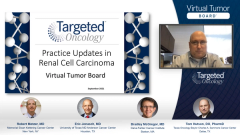
Case 1: Systemic Therapy Options in RCC
The expert panel discusses systemic therapy options recommended in NCCN Guidelines for patient with intermediate- and poor-risk mRCC.
Episodes in this series

Robert Motzer, MD: Eric, you’ve been a co-chair of the NCCN [National Comprehensive Cancer Network], for the kidney cancer guidelines. How do they see the therapy for an intermediate-risk patient in terms of regimens and preferred regimens at level 1? Can you give us a brief overview?
Eric Jonasch, MD: Thanks, Bob. The regimens that have preferred status in the intermediate- and poor-risk category in the NCCN Guidelines are ipilimumab-nivolumab, cabozantinib-nivolumab, pembrolizumab-axitinib, and pembrolizumab-lenvatinib. These are 4 very potent, excellent regimens that can probably provide benefit for this patient.
Robert Motzer, MD: One other question is what’s the optimal timing to start systemic therapy? The surveillance is certainly in the guidelines and part of our management. What do you think in terms of the timing of a therapy for a patient like this, Eric? Is this the time to start this patient therapy, or would you consider a surveillance approach?
Eric Jonasch, MD: The things that make me surveil a patient are clear evidence of indolence. If you have an individual who has an established lesion that you’re already following, and you see that that lesion is not changing very much in size over time—there are few of those—I would potentially observe the patient. Other organ sites of involvement—the pancreas, what we would call the glandular involvement, thyroid—seem to be somewhat more indolent, and there’s some interesting biology there. They seem to be more associated with the PBRM1 mutation. Those are the people I would certainly consider in that initial observation period. This individual is less than 1 year from diagnosis and nephrectomy, has multiple new lesions that have shown up somewhat abruptly, and has an elevated calcium. This isn’t the kind of patient I’d observe.
Robert Motzer, MD: There’s recently been reporting of several big phase 3 trials that have changed the paradigm and serve as the rationale for these NCCN recommendations, including 2 new indications, lenvatinib-pembrolizumab, cabozantinib-nivolumab. Tom, in your case, maybe you could tell us your decision for a first-line therapy regimen, then review some of the data from the trials.
Tom Hutson, DO, PharmD: Yes. I’d certainly initiate therapy in this person because they had more disease than what I would consider a small amount. I’m always balancing the understanding that if you start with smaller-volume disease, you’re more likely to get into a CR [complete response] situation than if you had just diffuse involvement of disease.
Tom Hutson, DO, PharmD: Based on the various clinical trials available, I feel that this patient would benefit most from an I/O [immuno-oncology]–TKI [tyrosine kinase inhibitor] regimen. I’d choose lenvatinib-pembrolizumab, which is our newest and arguably our most potent regimen.
Transcript edited for clarity.







































